Sandmann
Well-known member
Dear fellow collector friends,
I'm happy to present you my latest find, a helmet M1891. This rare enlisted man's helmet for a Prussian infantryman I have already acquired a few months ago, but unfortunately it came with a fake chinstrap and it took me some time to find the necessary original parts so that my friend Wojtek could stitch it together for me. I tried it on my own first, but stitching old leather is not a strength of mine because I'm just too clumsy.
So, dear Wojtek, once again: Thank you very much for your wonderful work.
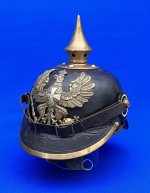
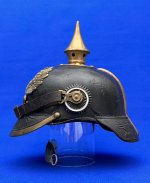
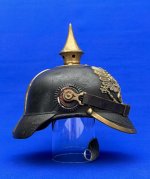
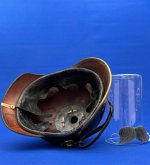
The wearer served last in the Landwehr Fusilier Regiment No. 40, but I could not make the name inside readable! According to the stamps, the helmet probably was first used in 1893. However, the double stitching in the area of the ear leather points to a modified helmet M71 or M87. Since the stamps on the rear visor not start before 1893, the visors may have been replaced rather than modified during this rework.
Characteristics of the pickelhaube:
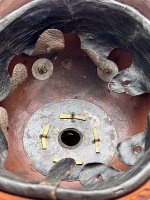
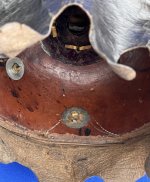
From 1895, the rosette had ø1.4 cm and 2 pins as anti-rotation.
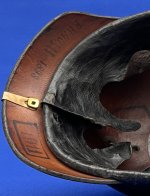
According to the stamp regulations I could imagine that these 6 stamps mean the following:
I'm happy to present you my latest find, a helmet M1891. This rare enlisted man's helmet for a Prussian infantryman I have already acquired a few months ago, but unfortunately it came with a fake chinstrap and it took me some time to find the necessary original parts so that my friend Wojtek could stitch it together for me. I tried it on my own first, but stitching old leather is not a strength of mine because I'm just too clumsy.
So, dear Wojtek, once again: Thank you very much for your wonderful work.




The wearer served last in the Landwehr Fusilier Regiment No. 40, but I could not make the name inside readable! According to the stamps, the helmet probably was first used in 1893. However, the double stitching in the area of the ear leather points to a modified helmet M71 or M87. Since the stamps on the rear visor not start before 1893, the visors may have been replaced rather than modified during this rework.
Characteristics of the pickelhaube:
- Height (incl. spike): 21,5 cm.
- Height of the shell: 9,5 cm
- Height of the spike: 8,7 cm.
- Diam. of the spikebase: 7,6 cm.
- Diam. of the blackened metal disc inside the helmet: 9,5 cm.
- Width of the front visor: 4,4 cm
- Width of the rear visor: 4,4 cm.
- Dimensions of the eagle plate (measured with tape measure): 11,0 cm (H) x 14,0 cm (W).

- Width of the chinstrap restored from original parts: 1.6 cm. Dimensions of the brass lugs on the chinstrap: 3.8 cm x 2.1 cm x 0.2 cm.
- Correct M91 rosette with ø1.3 cm and only 1 pin to prevent twisting.

From 1895, the rosette had ø1.4 cm and 2 pins as anti-rotation.
- Diameter of cockades: 4.7 cm.
- Correct liner with 9 lashes.
- Weight of the helmet: 453 grams.
- 6 visible stamps: 1893 - III - F.R.40 - 12 - II - 1911

According to the stamp regulations I could imagine that these 6 stamps mean the following:
- After production and acceptance, the helmet was stored in the storage room of the FR 40 (1st stamp). This happened in 1893 (2nd stamp).
- The III. Battalion confirmed the receipt of the helmet with the 3rd stamp.
- The helmet was handed out for the first time in 1911 (4th stamp), to the 12th Company (5th stamp). The helmet then probably belonged to the II. set of the wearer (6th stamp - I could imagine, because the helmet was in storage for a long time in 1911 and it was just given to a reservist)
Last edited:
